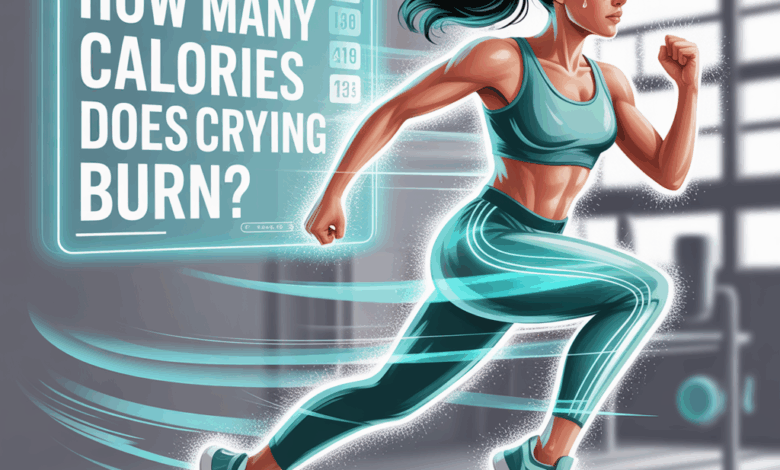How Many Calories Does Crying Burn

Have you ever wondered if a good cry counts as cardio? Picture this: you finish a long, emotional movie and wonder if the tears did anything for your waistline. It’s a funny thought, but many of us ask the same question—especially when we’re tracking calories and trying to squeeze every bit of movement into a busy day.
Quick answer: does crying burn calories?
Short version: yes, crying burns a small number of calories, but not nearly enough to serve as a meaningful weight-loss strategy. Emotional crying—shedding tears, sobbing and the small physical responses that come with it—elevates your breathing rate and heart rate a little, which uses some energy. That said, the energy cost is low compared with exercise like walking, running, or strength training.
How many calories does crying burn? A closer look
The exact number varies by person and intensity of crying. Here’s what to consider:
- Baseline metabolism: Your resting metabolic rate (RMR) accounts for most daily calorie burn. Crying adds only a tiny amount on top of that.
- Intensity and duration: Light tears and quiet sobbing might raise heart rate slightly; prolonged, intense sobbing and gasping for air could burn more—but still modestly.
- Individual factors: Age, sex, body weight, and fitness level affect energy expenditure.
Rough estimate: if crying increases your caloric burn by a few extra calories per minute, a 10–20 minute session might burn 10–50 extra calories. These are ballpark figures; scientific studies directly measuring calories burned while crying are limited. The key takeaway: crying is not an effective calorie-burning activity compared to a 30-minute brisk walk or a 20-minute HIIT session.
Why the number is small
Energy expenditure rises with muscular activity and sustained cardiovascular work. Crying engages facial muscles and alters breathing, but it doesn’t require the large muscle groups (legs, glutes, back) that consume the most calories during exercise. That’s why workouts that move those big muscles are far more efficient for burning energy.
Emotional benefits matter more than calories
Even though crying won’t replace your workouts, it can still support your fitness journey in meaningful ways:
- Stress reduction: Emotional release lowers cortisol for many people, which can decrease stress-related eating and improve sleep—both helpful for weight management.
- Mental reset: Crying can make it easier to refocus and be consistent with healthy habits like exercise or meal planning.
- Improved recovery: Emotional wellbeing supports recovery, motivation, and adherence to training programs.
Practical fitness tips to combine emotional health and caloric burn
If you’re looking to turn emotional moments into productive, health-forward choices, try these practical strategies:
1. Follow a cry with movement
- Go for a brisk 10–20 minute walk after an emotional release. Walking raises heart rate, clears the mind, and burns more calories than sitting and ruminating.
- If you prefer indoors, try a short bodyweight circuit: 3 rounds of 30 squats, 20 push-ups (or incline), and 30-second planks.
2. Use breathwork to calm and engage your core
Deep diaphragmatic breathing not only soothes the nervous system but also activates core muscles gently. Try 4–6 minutes of box breathing or alternate nostril breathing to reset after crying.
3. Add intentional movement into your routine
Built-in micro-workouts prevent emotional moments from derailing progress. Examples:
- Morning mobility + 20-minute strength session (2–3 times/week).
- 20–30 minutes of moderate cardio (cycling, swimming, brisk walking) 3–5 times/week.
- One HIIT workout per week to increase metabolic boost and calorie burn.
Workout variations that actually burn calories
Swap the idea of crying-for-calories with efficient, mood-supporting training options:
- Low-impact cardio: cycling, rowing, or brisk walking (good for joint health and stress management).
- Resistance training: compound lifts like squats, deadlifts, and rows build muscle and raise resting metabolic rate.
- Yoga and mobility: supports emotional regulation and flexibility while burning modest calories.
Check out our internal pages for detailed plans: workout routines and wellness tips for mood-focused training ideas.
Nutrition and lifestyle tips to complement emotional health
Your diet and daily habits influence how stress and emotions affect your body. Use these evidence-based tips:
- Prioritize sleep—aim for 7–9 hours. Poor sleep increases hunger hormones and makes emotional regulation harder.
- Eat balanced meals with protein, healthy fats, and fiber to stabilize blood sugar and mood.
- Practice regular self-care: sunlight exposure, social connection, journaling, and therapy when needed.
- Explore our nutrition guides for meal plans that support energy and emotional resilience.
Real-world examples
Example 1: After a stressful day and an emotional phone call, Sarah took a 20-minute walk. She felt lighter mentally and also burned calories, which reinforced her habit of moving after emotional events.
Example 2: Marcus used breathwork and a short bodyweight circuit after a cry. The combination helped him process feelings and stay consistent with his training schedule.
Frequently Asked Questions
There’s no exact number, but expect only a handful of extra calories—likely less than 50. The exact amount depends on intensity and your individual metabolism. For meaningful calorie burn, combine movement like walking or a brief workout.
Not directly. Crying itself burns very few calories and shouldn’t be relied on for weight loss. However, emotional release can reduce stress, improve sleep and decision-making, and indirectly support sustainable weight-management habits.
Potentially yes—louder, more physically intense sobbing might increase breathing and heart rate slightly more, burning more energy than quiet tearing. Still, the difference is minor compared to deliberate exercise.
Conclusion — tears, takeaways, and next steps
So how many calories does crying burn? While crying does use a small amount of energy, it’s not a substitute for real exercise. The real value of a good cry is emotional: stress relief, clearer thinking, and better recovery—factors that support your long-term fitness goals. After you’ve allowed yourself to feel, turn that emotional clarity into action: a short walk, a focused workout, or a nourishing meal can make a tangible difference in calorie burn and wellbeing.
Ready to channel emotion into progress? Explore our workout routines, check our nutrition guides, and try a few tips from our wellness tips page to build consistent habits that count more than any single tear. Share how you turn emotional moments into healthy action in the comments or start with a 10-minute walk today.





